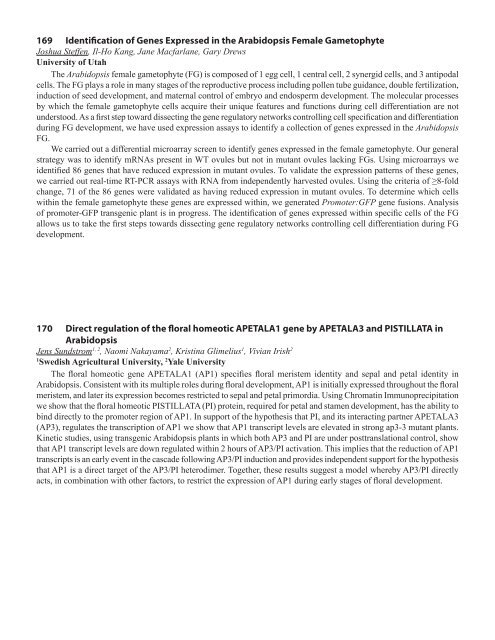75 Integrating Membrane Transport with Male Gametophyte ... - TAIR
75 Integrating Membrane Transport with Male Gametophyte ... - TAIR
75 Integrating Membrane Transport with Male Gametophyte ... - TAIR
Create successful ePaper yourself
Turn your PDF publications into a flip-book with our unique Google optimized e-Paper software.
169 Identification of Genes Expressed in the Arabidopsis Female <strong>Gametophyte</strong><br />
Joshua Steffen, Il-Ho Kang, Jane Macfarlane, Gary Drews<br />
University of Utah<br />
The Arabidopsis female gametophyte (FG) is composed of 1 egg cell, 1 central cell, 2 synergid cells, and 3 antipodal<br />
cells. The FG plays a role in many stages of the reproductive process including pollen tube guidance, double fertilization,<br />
induction of seed development, and maternal control of embryo and endosperm development. The molecular processes<br />
by which the female gametophyte cells acquire their unique features and functions during cell differentiation are not<br />
understood. As a first step toward dissecting the gene regulatory networks controlling cell specification and differentiation<br />
during FG development, we have used expression assays to identify a collection of genes expressed in the Arabidopsis<br />
FG.<br />
We carried out a differential microarray screen to identify genes expressed in the female gametophyte. Our general<br />
strategy was to identify mRNAs present in WT ovules but not in mutant ovules lacking FGs. Using microarrays we<br />
identified 86 genes that have reduced expression in mutant ovules. To validate the expression patterns of these genes,<br />
we carried out real-time RT-PCR assays <strong>with</strong> RNA from independently harvested ovules. Using the criteria of ≥8-fold<br />
change, 71 of the 86 genes were validated as having reduced expression in mutant ovules. To determine which cells<br />
<strong>with</strong>in the female gametophyte these genes are expressed <strong>with</strong>in, we generated Promoter:GFP gene fusions. Analysis<br />
of promoter-GFP transgenic plant is in progress. The identification of genes expressed <strong>with</strong>in specific cells of the FG<br />
allows us to take the first steps towards dissecting gene regulatory networks controlling cell differentiation during FG<br />
development.<br />
170 Direct regulation of the floral homeotic APETALA1 gene by APETALA3 and PISTILLATA in<br />
Arabidopsis<br />
Jens Sundstrom 1, 2 , Naomi Nakayama 2 , Kristina Glimelius 1 , Vivian Irish 2<br />
1<br />
Swedish Agricultural University, 2 Yale University<br />
The floral homeotic gene APETALA1 (AP1) specifies floral meristem identity and sepal and petal identity in<br />
Arabidopsis. Consistent <strong>with</strong> its multiple roles during floral development, AP1 is initially expressed throughout the floral<br />
meristem, and later its expression becomes restricted to sepal and petal primordia. Using Chromatin Immunoprecipitation<br />
we show that the floral homeotic PISTILLATA (PI) protein, required for petal and stamen development, has the ability to<br />
bind directly to the promoter region of AP1. In support of the hypothesis that PI, and its interacting partner APETALA3<br />
(AP3), regulates the transcription of AP1 we show that AP1 transcript levels are elevated in strong ap3-3 mutant plants.<br />
Kinetic studies, using transgenic Arabidopsis plants in which both AP3 and PI are under posttranslational control, show<br />
that AP1 transcript levels are down regulated <strong>with</strong>in 2 hours of AP3/PI activation. This implies that the reduction of AP1<br />
transcripts is an early event in the cascade following AP3/PI induction and provides independent support for the hypothesis<br />
that AP1 is a direct target of the AP3/PI heterodimer. Together, these results suggest a model whereby AP3/PI directly<br />
acts, in combination <strong>with</strong> other factors, to restrict the expression of AP1 during early stages of floral development.





